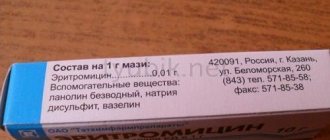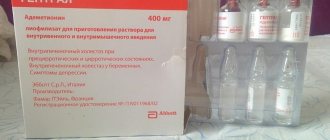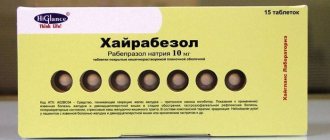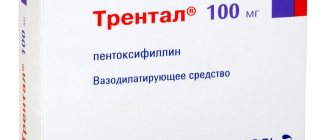Compound
The composition of the drug (1 tablet) includes the following active ingredients: 50 mg of rutoside , 345 units of pancreatin , 225 units of bromelain , 90 units of papain , 360 units of trypsin , 50 units of amylase , 34 units of lipase , 300 units of chymotrypsin (and pancreatin is presented in units ( ED) of the European Pharmacopoeia, and the remaining ingredients in units (U) of the International Pharmaceutical Federation).
Additional ingredients: stearic acid, lactose, talc, corn starch, purified water, magnesium stearate, colloidal silicon dioxide.
Shell composition: povidone, shellac, sucrose, methyl methacrylate-methacrylic acid copolymer, vanillin, talc, white clay, titanium dioxide, macrogol 6000, carnauba wax, triethyl citrate, bleached wax, dyes (crimson 4R and yellow-orange S).
Active Ingredients
Wobenzym is produced in the form of tablets, which are coated with a protective film shell of orange color with a pronounced specific odor. The drug is available in blisters of 20 pieces in a cardboard package.
Each tablet contains the following active ingredients:
- Chymotrypsin is a protease that breaks down food proteins;
- Trypsin is an enzyme of the hydrolase class that breaks down peptides and proteins;
- Rutin is a glycoside of the flavonoid quercetin. Belongs to the vitamin P group;
- Bromelain is a proteolytic enzyme obtained from pineapple that helps digest proteins;
- Pancreatin is a digestive enzyme agent, an extract of the contents of the pancreas;
- Amylase is an enzyme, glycoside hydrolase, that breaks down starch into oligosaccharides and is a digestive enzyme;
- Papain is a polypeptide, a proteolytic plant enzyme, that catalyzes the hydrolysis of proteins, peptides, amides and amino acid esters;
- Lipase is a water-soluble enzyme that catalyzes the hydrolysis of insoluble ester-lipid substrates and helps digest, dissolve and fractionate fats.
Auxiliary components: lactose, magnesium stearate, sucrose, silicon dioxide, corn starch, water.
Pharmacodynamics and pharmacokinetics
According to Medical Wikipedia (MedViki), the drug Wobenzym is a complex of highly active animal and plant enzymes ( enzymes ). These enzymes are carefully selected, optimally combined and included in Wobenzym tablets, which gives them a fairly wide range of clinical applications.
Taking Wobenzym has a positive effect on the course of the inflammatory process , reduces the pathological symptoms of immunocomplex and autoimmune reactions , and has a positive effect on the immunological reactivity of the human body. Under the influence of the active ingredients of the drug, the number of immune complexes the blood and their membrane deposits are removed from the tissues. The drug activates and corrects the functionality of natural killer cells ( lymphocytes ) and monocyte-macrophages , stimulates phagocytic cellular activity, cytotoxic T-lymphocytes and antitumor immunity , for which Wobenzym is often prescribed as an immunomodulator .
Treatment with Wobenzym reduces the infiltration of interstitial tissue by plasma cells , increases the elimination of deposits of fibrin and protein detritus from the inflamed area, accelerates the lysis of metabolic toxins and dying tissue structures, reduces swelling , accelerates the resorption of hematomas , and also normalizes the permeability of vascular walls.
The use of the drug leads to a decrease in thromboxane , a decrease in platelet aggregation , stabilization of blood cell adhesion, an increase in the plasticity of red blood and their ability to change their own shape, normalization of the number of platelets and a decrease in the total number of their activated fractions, regulation of blood viscosity and a decrease in the total number of microaggregates . the rheological parameters of the blood and its microcirculation improve , which ensures a normal supply of tissues and organs of the human body with nutrients and oxygen.
Wobenzym reduces the replication of endogenous cholesterol , normalizes lipid , increases HDL , reduces the content of atherogenic lipoproteins and improves the absorption of polyunsaturated fatty acids .
The administration of Wobenzym enhances the effectiveness of antibiotic therapy by increasing the level of antibacterial agents in the source of inflammation and their plasma concentrations, triggers the process of nonspecific defense of the body (production of interferons ), thereby exhibiting antimicrobial and antiviral effects, and also eliminates the symptoms of dysbiosis . The drug also reduces the severity of side effects that occur when taking hormonal medications (including hypercoagulation ).
When taken orally, due to the resorption of dimeric molecules , the active ingredients of Wobenzym are absorbed from the small intestine with the formation of protein complexes and further entry into the vascular bed. Circulating through the systemic bloodstream, enzymes enter areas of pathological processes, where they accumulate.
How the drug works
All enzymes included in the composition are selected in such a way that the drug can provide the widest possible range of clinical effects. The positive properties of Wobenzym are manifested as follows:
- The drug has anti-inflammatory, antimicrobial, immunomodulatory effects, increases fibrinolytic activity of the blood, regulates metabolic mechanisms, improves tissue permeability and saturates them with oxygen.
- Wobenzym increases the release of protein detritus (decomposition product) from the inflamed area and accelerates the destruction of toxins, corrects the number of lymphocytes, reduces the concentration of thromboxane and other thyroid antibodies.
- Under the influence of Wobenzym, hematomas dissolve faster, dying tissue structures are removed from the body, and swelling decreases.
- Combinations of enzymes reduce the severity of side effects and hypercoagulation (increased blood clotting) due to hormonal therapy, and increase the effectiveness of antibiotics.
- Regular use of the product helps reduce the level of bad cholesterol, increases the plasticity of red blood cells, normalizes platelet counts, regulates the viscosity of blood plasma, and normalizes the permeability of vascular walls.
- Enzymes have a beneficial effect on the digestive tract, normalize lipid metabolism, and improve the absorption of polyunsaturated fatty acids.
Indications for use of Wobenzym
The abstract for Wobenzym positions it as a means for use in combination with other drugs used for the treatment of certain pathologies, as an addition to the main treatment. Indications for the use of the drug cover many areas of medicine and recommend its use in the following cases.
In angiology:
- lymphatic;
- thrombophlebitis;
- endarteritis;
- postthrombophlebitic disease;
- arterial obliterating atherosclerosis of the legs;
- recurrent phlebitis (prevention).
In gynecology:
- miscarriage (relative to the second and third trimester);
- endometritis;
- salpingo-oophoritis;
- cervicitis;
- vulvovaginitis;
- mastopathy;
- gestosis;
- reducing the severity and frequency of negative events during hormone replacement therapy;
- chlamydia;
- mycoplasmosis;
- ureaplasmosis.
In gastroenterology:
- dysbacteriosis (dysbiosis);
- chronic inflammatory pathologies of the gastrointestinal tract;
- hepatitis.
In dermatology:
- acne ( acne );
- atopic dermatitis;
- itchy dermatoses.
In neurology:
- chronic cerebral circulatory disorders;
- multiple sclerosis.
In cardiology:
- myocardial infarction in the subacute stage;
- angina pectoris.
In nephrology:
- glomerulonephritis;
- pyelonephritis.
In otorhinolaryngology:
- otitis;
- sinusitis;
- laryngitis;
- sinusitis.
In ophthalmology:
- iridocyclitis;
- uveitis;
- hemophthalmos;
- glaucoma;
- diabetic retinopathy;
- ophthalmic surgery and prevention of postoperative complications.
In oncology:
- radiation and chemotherapy (to improve tolerability);
- reducing the risk of secondary infections.
In pulmonology:
- tracheobronchitis;
- pneumonia;
- bronchitis;
- tuberculosis;
- obstructive bronchitis.
In dentistry:
- diseases of the oral cavity of an infectious-inflammatory nature.
In rheumatology:
- osteoarthritis;
- arthritis of various etiologies.
In urology:
- cystitis;
- sexually transmitted infections;
- prostatitis;
- cystopyelitis.
In traumatology:
- inflammatory processes of soft tissues;
- various injuries ;
- post-traumatic manifestations of a chronic nature;
- sports injuries.
In pediatrics:
- pathologies of the respiratory tract of infectious and inflammatory origin;
- atopic dermatitis;
- postoperative complications ( adhesive disease , insufficient wound healing, local swelling and suppuration ).
In surgery:
- lymphatic and post-traumatic edema ;
- postoperative complications ( edema , thrombosis , inflammation ).
In endocrinology:
- retinopathy and angiopathy (diabetic);
- autoimmune thyroiditis.
Additionally, indications for Wobenzym include the prevention of the following conditions:
- acclimatization and adaptation;
- microcirculation disorders;
- post-stress disorders;
- vascular accidents;
- negative phenomena during hormonal therapy ;
- viral infections or their subsequent complications;
- dysbiotic disorders during antibiotic therapy .
Contraindications
Before taking Wobenzym, you should familiarize yourself with the contraindications for its use, for which below are the conditions in which treatment with Wobenzym is absolutely prohibited:
- any pathologies that occur with an increased risk of bleeding ;
- age up to 5 years;
- personal hypersensitivity to active and/or additional components of drugs;
- carrying out hemodialysis .
Side effects
Wobenzym therapy in most cases is tolerated without negative effects during treatment and without negative consequences after its completion. Also, so far there has been no evidence of side effects of the drug, addiction to it or the formation of a withdrawal syndrome , even in the case of long-term therapy using high dosages.
urticaria was noted , as well as minor deviations in the smell and consistency of stool , which were leveled out by reducing the dose of the drug or disappear after discontinuation of treatment.
Before prescribing Wobenzym, the patient must be warned that if he experiences any adverse reactions associated with taking the drug, his responsibility is to immediately stop therapy and further consult a doctor.
Side effects and contraindications
According to the instructions, for hemophilia, thrombocytopenia and people with individual intolerance to one or more components, the drug is prohibited from taking. Pregnant women should take the tablets with caution from weeks 1 to 14 if they are taking other medications. Even in the treatment of chronic long-term diseases, addiction/withdrawal syndromes or cases of drug overdose were not observed. Wobenzym is well tolerated by patients, but rarely the following may occur:
- nausea or vomiting;
- heaviness in the stomach;
- bowel dysfunction;
- change in stool odor, diarrhea;
- allergic reactions - skin rashes, itching, urticaria.
Wobenzym tablets, instructions for use
Instructions for use Wobenzym recommends taking whole tablets of the drug orally (orally) half an hour before meals with 150-200 ml of water.
As a rule, the dosage regimen, as well as the duration of treatment, is determined individually, taking into account the disease itself, its severity, as well as all internal and external factors affecting the patient’s condition.
For adult patients, the range of single doses of the drug, depending on the pathology, its severity and activity, is 3-10 tablets with a mandatory dose of three times a day. Usually, during the first three days of therapy, they resort to taking 3 tablets three times every 24 hours. The further number of tablets taken at one time may vary, while the frequency of their intake per day in all cases remains unchanged (3 times every 24 hours).
For moderate painful conditions, 5-7 tablets are prescribed three times a day for 14 days. In the future, they switch to taking 3-5 tablets with the same frequency of administration. The general course of treatment is approximately 30 days.
For severe painful conditions, 7-10 tablets are prescribed three times a day for 14-21 days. Subsequently, the dosage is reduced to 5 tablets with the same frequency of administration. The general course of therapy is 2-3 months.
For chronic pathologies, Wobenzym tablets are recommended to be taken according to indications and observed symptoms, in courses of 3 to 6 months.
To potentiate the effectiveness of antibiotic therapy and prevent the formation of dysbiosis , a three-time daily dose of 5 tablets is recommended throughout the entire course of antibiotic . In order to treat dysbiosis that occurs after antibiotic therapy, 3 tablets are prescribed three times every 24 hours for 14 days.
When carrying out chemotherapy and radiation therapy , it is recommended to take Wobenzym three times a day, 5 tablets throughout the entire duration of treatment, in order to improve its tolerability, prevent complications of infectious etiology and improve the overall quality of life.
To prevent various pathological processes, take the drug for 45 days, 3 tablets three times a day. This preventive course can be repeated 2-3 times a year.
Children's (5-12 years old) dosages of Wobenzym are calculated based on the proportion of 1 tablet per 6 kg of weight.
Is Wobenzym a pacifier or a medicine?
I was recently asked about a product called Wobenzym N, a product with German roots that is advertised with the following claims:
Taking Wobenzym®N as directed will help support several key systems in your body. This product supports musculoskeletal function, promotes joint and muscle health and mobility, and has been used for decades. Wobenzym®N supports the circulatory system, promoting healthy veins. This product also supports the respiratory system and sinus health. Wobenzym®N is used by many people to support a balanced immune system and promote healthy aging. Wobenzym® is safe and effective and has been used by more than 100 million people for over 40 years worldwide.
Vague and unspecific statements. But what does Wobenzym N actually do? Other sites promoting its use go much further in their treatment claims, describing use for conditions ranging from Alzheimer's disease and angina to multiple sclerosis, prostatitis, respiratory infections and even uveitis. Some mention usefulness in treating cancer. What ties all these disparate diseases together? David Gorski calls this the One True Cause. When you use systemic enzymes, your “OTC” of all diseases is inflammation.
Rubor, color, dolor, edema
Inflammation (lat. inflammatio) is a complex, local and general pathological process that includes.
lat. rubor - redness (local redness of the skin or mucous membrane). tumor - tumor (edema). calor - heat (increase in local temperature). dolor - pain. Supplemented by Galen (129 - ca. 200 AD), adding. Inflammation is our body's response to infection or injury and is part of the healing process. Diseases with an inflammatory component are common and have a huge impact on health—think asthma, arthritis, and inflammatory bowel disease—all common chronic diseases that affect millions of people. Low-grade inflammation associated with obesity may be responsible for a number of obesity-related complications. But “inflammation” doesn’t come in one form. There are several mediators such as cytokines and exanoids. There is a wide range of cellular responses. As Peter Lipson explained earlier:
Inflammation is a medical term that refers to a variety of complex physiological processes mediated by the immune system. Inflammation gets its ancient name from the telltale physical signs of inflammation: redness, odor, heat, pain and swelling. Because vitalistic ancient medical beliefs were worshiped by modern science, inflammation was recognized as much more complex than just these four external characteristics. In addition to being a response to injury and disease, inflammatory cellular and chemical reactions can also cause disease itself. For example, in asthma and food allergies, a type of immune response called type I hypersensitivity causes a harmful type of inflammation. Coronary heart disease, the leading cause of death in Americans, is thought to have a significant inflammatory component. Although there may be inflammatory components to many different diseases, it is very simplistic to think that we can treat all forms the same until there is evidence that this is the case. Asthma and arthritis have inflammatory elements, but they are different diseases with different treatments. But simplify the terms to just be "inflammation" and you can introduce an equally simple solution.
Is this the solution?
Systemic enzyme therapy:
Wobenzym®N provides “systemic enzyme support,” which describes the process that uses enzymes to support the body's various regulatory and communication systems, particularly the immune system. †A balanced immune system is essential to maintaining overall health. Active enzyme molecules must be readily available in the small intestine to ensure systemic effect of the enzymes. Enzymes play a critical role in the body and are involved in a surprising number of metabolic processes. Scientists suspect that there may be up to 15,000 enzymes in our bodies every day. Enzymes are involved in a variety of body processes, including: respiration, growth, digestion, energy production, conduction of nerve impulses, blood clotting, recovery from exercise, or balancing complex immune system processes.
Enzyme supplements may be science-based. The use of enzymes for pancreatic diseases is common, as well as for diseases such as cystic fibrosis. But these are not cases when enzymes should be absorbed from the gastrointestinal tract. Systemic enzyme replacement is something else.
I first encountered the idea of massive enzyme superdoses when I learned about the Gonzalez regimen, an alternative cancer treatment regimen that has been discussed in detail in previous articles by Kimball Atwood. Treatment includes coffee enemas and hundreds of pancreatic digestive enzyme tablets per day. The regime itself was based on assumptions about the causes of cancer that have now been definitively refuted. A clinical trial of Gonzalez's regimen was funded by the National Center for Complementary and Alternative Medicine (NCCAM), which included a large number of pancreatic enzymes.
The results of the study were remarkable, but not in a positive way for the “alternative” approach.
Traditional chemotherapy treatment for pancreatic cancer was three times better than Gonzalez's regimen. Our pancreas secretes enzymes that help digest food. Should we expect the enzymes we consume to be absorbed into the body? Enzymes are large proteins that act as catalysts for biochemical reactions in the body—many chemical transformations are catalyzed by the enzyme.
Many parameters can influence enzyme activity, including pH and temperature, and the presence of activators and inhibitors. Given the importance of enzymes in the body, genetic disorders that affect enzyme production and function can have catastrophic consequences. We also expect that the production and distribution of enzymes in the body will be quite tightly controlled, given the potential effects, and given that the food we eat will have its share of naturally occurring enzymes.
The use of proteins as therapeutic agents to target disease is of considerable scientific interest. The problem with introducing proteins into the body is that most are quickly eliminated from the circulation, whether through enzyme biotransformation or renal filtration. Very large doses may be required, increasing the likelihood of nonspecific toxicity and even allergic reactions. The most common therapeutic use of proteins is injection because large chemical molecules are typically either broken down by our endogenous digestive enzymes or, if they survive, unable to cross membranes into the bloodstream.
Thus, the concept of administering enzymes orally and achieving meaningful therapeutic effects in the body poses a significant number of obstacles to the development of oral enzyme drugs. What's happening? Looking at Wobenzym N, each enteric-coated tablet contains:
- Bromelain 45 mg
- Chymotrypsin 1 mg
- Pancreatin 100 mg
- Papain 60 mg
- Rutin 50 mg
- Trypsin 24 mg
The recommended dosage is 3 tablets, twice a day, 45 minutes before meals. Before examining the clinical data, I wanted to better understand the composition and dosage, taking into account issues of the structure and structure of the tablet itself and its use.
PRML
Each summary of drug characteristics (“monograph”) will have the same section. This is an abbreviation of PRML, which stands for Absorption, Distribution, Metabolism and Elimination.
This section describes the behavior of the chemical in the body. This is not a clinical section describing therapeutic effects. It simply describes how widely and how quickly a drug is absorbed from the gastrointestinal tract, where it is distributed in the body ("volume of distribution"), how and if it is broken down or "biotransformed" so that it is more easily eliminated, and how quickly it is eliminated from the body. (I described this process in more detail in a previous post about generic drugs.)
This is the basic pharmacological work that is done on a drug, which gives us information to understand its characteristics in the body. There is no point in conducting clinical trials on a chemical packaged in a tablet if we cannot confirm that the active ingredient is actually absorbed when it is consumed. Clinical trials follow the main pharmacological work. If a drug treats different conditions, we may need to study different doses to establish the dose for each condition. (For example, to treat rheumatoid arthritis, you need to take much more of an anti-inflammatory drug than to treat a headache).
This is a pharmacokinetic study, and it allows us to determine how a drug should be dosed and delivered to the body. If the medication is slowly eliminated, so dosing may be infrequent - daily or even weekly? Is the enzyme cleared from the body quickly, meaning we need to take doses multiple times a day to stay in the “sweet spot” of the therapeutic range? How is it removed from the body? Is it converted by the liver? What effect does changing the dose have on product elimination? What dose range studies have been performed on the product that established the appropriate dose?
And how does this dose vary depending on the condition being treated?
My reason for discussing this point is that understanding PRML is essential to the rational use of medications, supplements, or chemicals of any kind. With herbs, this is the difference between herbs and pharmacognosy. Without this, dosing of any product is empirical - a shot in the dark. Coming back to Wobenzym N, we have a combination product with six different ingredients. Dosage instructions are very specific: 3 enteric-coated tablets, twice daily, 45 minutes before meals. This is the same for all the reasons for use described. But why this dose? Why 3 tablets? Why twice a day? What happens if you take more or less? Different ingredients usually have their own physical and chemical characteristics. What effects does each have? I first looked at each ingredient in the Natural Medicines Database (NMCD) and then in the primary literature itself.
Here's what I could find:
Bromelain
is a term used to refer to enzymes isolated from pineapple. Although the NMCD rates it as "possibly effective" for osteoarthritis, evidence conflicts with some studies suggesting it has no effect on osteoarthritis. It has not been well demonstrated that bromelain reaches any significant concentration in the blood. These are large protein molecules, and it is unclear how efficiently they are absorbed—doses of 3,000 mg/day seem to result in tiny, albeit measurable, blood levels. Blood plasma components may inactivate any absorbed bromelain, although the half-life has been described there. Overall, the data is not impressive.
Chymotrypsin
is a protein digesting enzyme that is synthesized and secreted by the pancreas. I could not find any published effectiveness of adjunctive single-component chymotrypsin for any condition. It is not clear what additional benefit a few milligrams would have from this ingredient. I have not been able to find any information that characterizes him as PRML.
Pancreatin
is a mixture of digestive enzymes, including lipase, protease and amylase, and is used as a prescription drug to treat pancreatic insufficiency in conditions such as cystic fibrosis. High doses have been associated with increased blood/urine uric acid levels. There is no established use of oral pancreatin for anything other than pancreatic inefficiency. Again, little information exists to describe PML.
Papain
is a derivative of papaya enzymes. I could find one study (in German) that compared oral supplements with acyclovir for herpes zoster pain. Given the limited information in the abstract, it is not possible to evaluate the data more fully. Little data exists to characterize PRML.
Rutin
is a flavenoid rated as "possibly effective" for osteoarthritis based on a single double-blind trial of an enzyme product (bromelain, trypsin and rutin) compared with diclofenac. Rutin does not appear to be absorbed intact because it increases plasma quercetin levels and appears to interfere with the absorption of other drugs. Again, little information exists to understand the pharmacokinetics.
Trypsin is another enzyme produced in the pancreas to digest proteins. Apart from the rutin study, I could not find any published trials evaluating effectiveness for any other condition. There is limited information to describe PML.
As I have noted, getting large proteins, such as enzymes, to be absorbed is a drug development challenge.
Even if they were absorbed, how large molecules would escape rapid metabolism and elimination is also unclear.
With the ingredients in Wobenzym N, there appears to be some data to suggest that some components do reach the bloodstream.
And there are some studies with individual ingredients - but nothing that clearly has a MEANINGFUL effect. With this in mind, I looked for studies using Wobenzym's ingredient combination.
Research
I reviewed the review using the Natural Medicines Comprehensive Database (NMCD).
Regarding Wobenzym N, in particular, it is said: Wobenzym N helps reduce inflammation and swelling, and also accelerates recovery from certain injuries. It is often used by people with arthritis and by athletes, including some professional and Olympic athletes. The enzymes in this product are "thought" to activate macrophages, which attack inflammatory-causing circulating immune complexes. Rutoside, an additional ingredient, acts as an antioxidant. To date, there is no convincing clinical evidence that wobenzym is effective for these purposes. Because these enzymes do not interfere with prostaglandin synthesis, Wobenzym N is also considered free from many of the side effects associated with nonsteroidal anti-inflammatory drugs (NSAIDs). Adverse reactions reported following oral administration include loose stools, increased gas, and skin reactions. NMCD warns that the product may also affect blood clotting.
Are there any clinical trials with Wobenzym? Yes, but little in English, which makes it difficult to review. I couldn't find any evaluation trials in PubMed, but other websites list trials for conditions such as pelvic inflammatory disease, cancer and multiple sclerosis (URL removed - malware site! -Webmaster). Some therapeutic benefits have been attributed to Wobenzym consumption (eg, diabetes, post-heart attack), but studies are preliminary, sometimes blinded, and do not appear to be replicated. One of the few English-language newspapers appeared in Medical Hypotheses, which is not a good sign for those seeking scientific medicine. The study, published in Russian, is an uncontrolled study of bronchitis in children. Other studies are published in Czech, Ukrainian, Latvian and Russian. One German systematic review states that "oral treatment with proteolytic enzymes does not offer a justifiable alternative compared to NSAIDs in the anti-inflammatory treatment of rheumatic diseases." Overall, there are no large clinical trials with relevant clinical outcomes and no compelling evidence demonstrating clinically significant effects for any individual condition for which Wobenzym is used for treatment. Overall, the product's safety profile appears acceptable, but it is unclear how much safety data was collected in these small trials.
There are several trials with a similar product, Phlogenzym (rutoside, bromelain and trypsin). No one has offered impressive results for ankle treatment. A trial studying the same combination for hip osteoarthritis suggested noninferiority with diclofenac, and an open-label study for knee osteoarthritis also found noninferiority. I even found a small trial declaring it effective for treating sepsis in children and was curious if India had research ethics boards.
There is also an interesting case of the enzyme serrapeptase, also marketed as an anti-inflammatory agent. Marketed by the pharmaceutical company Takeda since 1968 to treat asthma, bronchitis and promoted as an anti-inflammatory enzyme for a variety of other uses, it was withdrawn from the Japanese market in 2011 after double-blind trials showed it had no therapeutic benefit.
Overall, looking at the systemic enzyme data, I was not impressed. Despite the general claim of effectiveness, there are so many limitations in the data itself that it is not clear how we can conclude that the treatment effects are REAL. And given the lack of data on the absorption, distribution, metabolism and elimination of Wobenzym, it is unclear that this product is even slightly absorbed and available in the body to have systemic effects. Without some objective measure to assess effectiveness, it is not clear that supplements will have any significant therapeutic effects for any condition, chronic or otherwise. You may feel better when you take it, but there is no conclusive evidence yet that it has a significant effect - it is effectively a placebo.
special instructions
With the development of infectious processes, taking Wobenzym cannot replace antibiotic therapy , but significantly enhances its effectiveness by increasing plasma concentrations of antibiotics and their content at the site of inflammation.
It is necessary to take into account the ability of the drug to enhance the symptoms of the underlying disease at the very beginning of its use. Such manifestations are leveled out by reducing the dosage of Wobenzym and do not require discontinuation of treatment.
Wobenzym's analogs
Level 4 ATX code matches:
Serrata
Similar Wobenzym preparations, belonging to the same pharmacological group, are represented by a fairly wide list of medicinal substances and are mainly prescribed for one or two painful conditions, while the purpose of Wobenzym covers pathologies of many systems and organs of the human body
The most famous analogues of the drug are: Anaferon , Broncho-Vaxom , Galavit , Immunal , Imudon , Wobenzym , Neuroferon , Ribomunil , Cycloferon , Engistol .
Taking into account some similarity in the composition of drugs and the distribution of their effects on the human body, we can distinguish two analogue drugs - Vobe-mugos E and Phlogenzyme .
The price of Wobenzym analogs (40 tablets) (using the example of these two drugs that are closest in action) is slightly higher for Flogenzym - 950 rubles and much higher for Wobe-mugos E - 2900 rubles, for the same number of tablets.
The effectiveness of Wobenzym - truth or myth
The drug is officially registered in Russia as a medicine, the same confirmation for Wobenzym was given in European countries, and only in the USA is it considered a dietary supplement. The original composition of Wobenzym was developed by Professor Wolf and Dr. Benitez in the 50s of the last century. During this time, the drug was used in six clinical studies involving more than 2,400 patients.
Due to its positive effects on the human body, many doctors consider Wobenzym to be an indispensable assistant in radiation therapy and hormone replacement treatment. There are many positive reviews from gynecologists about the drug Wobenzym. They believe that this medication is effective for inflammation of the appendages, colpitis and cystitis. However, the medicine should not be considered a universal remedy. Remember that all its positive qualities are revealed only with an integrated approach to the problem.
With alcohol
It should be noted right away that with any pathology, taking any medications, and even against the background of complete health, alcohol, especially in large quantities, cannot benefit the human body. When considering the compatibility of Wobenzym treatment with the intake of alcoholic beverages, one should also take into account the fact that this drug itself is prescribed quite rarely, but is mainly part of the complex treatment of certain diseases, which indicates the variety of possible effects of complex therapy on the body as a whole. and on its individual organs and systems. For example, when used in combination with antibiotics , antiviral drugs , chemotherapy drinking alcohol is strictly prohibited, and with other combinations of drugs, its use is undesirable and, at best, can lead to a decrease in the effectiveness of therapy, and at worst, cause various severe complications . Another area of application of the drug is the treatment of withdrawal symptoms , and in this case Wobenzym and alcohol are compatible in the same way as the concepts of benefit and harm themselves.
Can it be combined with other drugs?
The drug is combined with different drug groups. There were no signs of negative interaction during complex treatment. However, the drug should be taken with caution in combination with medications that can reduce blood clotting. By increasing the antiviral and antimicrobial functions of the body, the drug increases the level of concentration of antibiotics in the blood and places where inflammatory processes are localized.
Wobenzym reduces the side effects of antibiotics.
Against the background of the use of hormonal drugs, the drug also stimulates the functioning of protective mechanisms, improves antiviral and antimicrobial effects.
Wobenzym during pregnancy and lactation
The list of contraindications for the use of Wobenzym does not include either pregnancy or breastfeeding . Moreover, during pregnancy, women are even recommended to take it to prevent miscarriage, starting from the second trimester, where the effect of the drug receives positive reviews. During pregnancy, the calculation of the dosage and duration of taking the tablets is determined individually, taking into account the general condition of the expectant mother, fetal health indicators and the course of the pregnancy itself.
Reviews of Wobenzyme
Reviews about Wobenzyme on forums, as well as reviews from doctors about Wobenzyme, are quite contradictory and often lead to serious disputes among specialists and patients about the effectiveness, usefulness and safety of using this drug. The opinions of many doctors and people who have ever taken this drug differ radically on this matter, and when some claim that for them complex treatment with the inclusion of Wobenzym was much more effective and safer than without it, others immediately find many arguments against and declare the complete uselessness of this drug.
For example, some nutritionists advise taking Wobenzym for weight loss in combination with diet and exercise and explain this by the drug’s ability to normalize the function of the gastrointestinal tract and their microflora . Some patients who have undergone this course of diet therapy remain satisfied with its results and leave positive reviews about Wobenzym. The other part, which does not notice any special changes in body weight, naturally attributes the negative result to Wobenzym.
Reviews about the drug in gynecology when planning pregnancy ; for mastopathy , endometritis , vulvovaginitis , gestosis , cervicia ; diseases of sexual etiology ( chlamydia , mycoplasmosis , ureaplasmosis ), as well as reviews of Wobenzyme during pregnancy are mostly positive, but even here there are those who see in this only a coincidence and the effect of other drugs taken in parallel.
In the current situation, it is not possible to draw any definite conclusions and therefore we can only advise you to rely on the opinion of your attending physician, especially if you trust him not only as a good specialist, but also as simply a decent person.
Wobenzyma price, where to buy
The price of Wobenzym in Russian pharmacies, due to its considerable cost, does not differ much depending on the region and therefore you can buy Wobenzym in Moscow for about the same as it costs in St. Petersburg, for example, at the Ozerki pharmacy.
The average price of 40 tablets is 450 rubles; 200 tablets – 1900 rubles; 800 tablets – 6500 rubles. The price of 100 Wobenzym tablets, when purchased “by weight” from a package of 800 pieces, is 900-1000 rubles.
Wobenzym can be bought in Kyiv on average for: No. 40 – 200 hryvnia; No. 200 – 900 hryvnia; No. 800 – 3000 hryvnia.
- Online pharmacies in RussiaRussia
- Online pharmacies in UkraineUkraine
- Online pharmacies in KazakhstanKazakhstan
Pharmacy Dialogue
- Wobenzym (tab. p/o No. 200) Mucos
2291 rub. order - Wobenzym (tablet No. 40)Mucos
RUR 504 order
- Wobenzym (tab. p/o No. 800) Mucos
RUR 7,539 order
show more
PaniPharmacy
- Wobenzym tablets Wobenzym coated tablets No. 40 Germany, Mucos Emulsionsgesellschaft
216 UAH.order - Wobenzym tablets Wobenzym coated tablets No. 800 Germany, Mucos Emulsionsgesellschaft
3029 UAH. order
- Wobenzym tablets Wobenzym coated tablets No. 200 Germany, Mucos Emulsionsgesellschaft
903 UAH order
show more
How much does Wobenzym cost?
A package of tablets can be purchased through pharmacy chains or ordered at a lower price through an online pharmacy catalog. The drug is available without a doctor's prescription, and its price depends on the region of sale and the form of release of the drug. Where to buy Wobenzym inexpensively in Moscow and St. Petersburg is described in the table:
| Pharmacy name | Volume of the drug | Price, rubles |
| ZdravZone | №40 | 364 |
| №200 | 1635 | |
| №800 | 5397 | |
| ElixirPharm | №40 | 373 |
| №200 | 1698 | |
| №800 | 7042 | |
| Europharm | №40 | 480 |
| №200 | 2199 | |
| №800 | 6990 |








